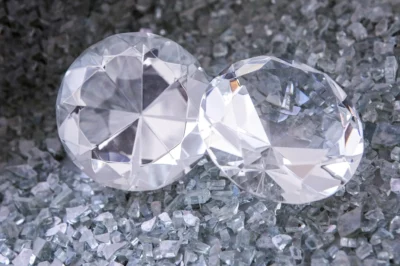Diamonds have fascinated us for centuries. They shine, they sparkle, and they symbolize everything from everlasting love to unimaginable wealth. But among these glittering gems, some are so rare and extraordinary that they capture the world’s imagination. We’re talking about the rarest diamonds in the world — the ones with colors so unique and sizes so jaw-dropping that they defy the ordinary. Whether you’re a collector, investor, or just a lover of all things beautiful, this deep dive into rare diamonds will leave you amazed.
What Makes a Diamond Rare?
When it comes to diamonds, rarity can come from several factors. Most people think size is the only thing that matters, but in the world of gemology, rarity goes beyond carats. Color, clarity, origin, and historical significance all contribute to what makes a diamond truly one-of-a-kind.
Uncommon Colors
Most diamonds you see in engagement rings or necklaces are colorless or near-colorless. But every once in a while, Mother Nature produces a diamond in shades of blue, pink, green, or even red. These fancy-colored diamonds are incredibly rare and highly coveted.
- Red diamonds are the rarest of all.
- Blue diamonds are extremely scarce and stunning.
- Pink diamonds have a romantic hue and have skyrocketed in value.
- Green, orange, and violet diamonds are also extremely rare and valuable.
Exceptional Size and Carat Weight
Diamonds over 100 carats are almost mythical. The larger the diamond, the rarer it becomes. But size alone isn’t enough—the diamond also needs to have clarity, brilliance, and overall aesthetic beauty.
Historical and Geological Rarity
Some diamonds come from legendary mines like Golconda in India or Cullinan in South Africa. Others have belonged to royalty or have stories filled with mystery and intrigue. This kind of provenance can elevate a diamond from rare to priceless.
The Most Famous Rare Colored Diamonds in the World
The Moussaieff Red Diamond
Meet the rarest of them all: the Moussaieff Red Diamond. Weighing in at 5.11 carats, this Fancy Red diamond is not only incredibly rare in color but also in size. Most red diamonds are under 1 carat. The Moussaieff Red dazzles with a deep hue that defies explanation.
The Hope Diamond
If there’s a diamond with a legacy, it’s the Hope Diamond. This deep-blue gem weighs 45.52 carats and is famously housed in the Smithsonian Institution. It has a rich history that spans continents and centuries and is even rumored to be cursed—which, naturally, only makes it more famous.
The Pink Star Diamond
One of the most visually striking diamonds in existence, the Pink Star is a Fancy Vivid Pink diamond weighing a stunning 59.60 carats. It broke auction records when it sold for over $70 million, making it one of the most expensive diamonds ever sold.
The Dresden Green Diamond
At 41 carats, the Dresden Green is the largest natural green diamond known. Its unique hue and historical significance (dating back to the 18th century) make it a gem of immense importance.
The Ocean Dream Diamond
A Fancy Deep Blue-Green diamond, the Ocean Dream is as rare as its name suggests. It’s the only known natural diamond of its color in the world, making it a gemologist’s fantasy.
The Cullinan Diamond
The largest gem-quality rough diamond ever found, the Cullinan Diamond originally weighed 3,106 carats. Discovered in South Africa in 1905, it was later cut into several stones, some of which now reside in the British Crown Jewels.
The Lesedi La Rona
At 1,109 carats, this diamond is the second-largest gem-quality rough diamond ever discovered. Unearthed in Botswana in 2015, it stunned the world with its size and clarity.
The Excelsior Diamond
Discovered in 1893, the Excelsior Diamond weighed 995.2 carats in its rough state. It was mysteriously underpublicized compared to other large diamonds, yet remains one of the biggest ever found.
The Koh-i-Noor Diamond
Few diamonds are as famous or controversial as the Koh-i-Noor. Weighing 105.6 carats, it has a history steeped in legend and colonial controversy. Currently part of the British Crown Jewels, it continues to spark debates about ownership and heritage.
Rare Color Combinations and Grading Insights
What is a Fancy Color Diamond?
In gemology, colored diamonds are graded differently from colorless ones. The Gemological Institute of America (GIA) uses terms like “Fancy Light,” “Fancy Intense,” and “Fancy Vivid” to describe colored diamonds.
- Fancy Light: Soft hue, less saturation
- Fancy Intense: Richer color
- Fancy Vivid: The most vibrant and rare
Rarity by Hue and Intensity
It’s not just the color that counts, but how deep and pure that color is. A Fancy Vivid Blue is exponentially rarer than a Fancy Light Blue. Combine that with high clarity and significant size, and you have something incredibly rare and valuable.
Why Color + Size = Explosive Value
A large diamond with an intense or vivid color is a unicorn in the gem world. These diamonds often fetch astronomical prices at auction because their rarity is essentially unmatched.
Where Do Rare Diamonds Come From?
Legendary Mines Around the World
- Golconda Mines, India: Produced the Koh-i-Noor and Hope Diamond
- Cullinan Mine, South Africa: Source of the Cullinan Diamond
- Argyle Mine, Australia: Known for pink diamonds (now closed)
- Lulo Mine, Angola: One of the newer sources of large gem-quality diamonds
New Discoveries and Future Sources
The diamond mining industry is changing. With many traditional mines closing or nearing depletion, new sources are being explored. Meanwhile, lab-grown diamonds are gaining popularity, but they can’t replicate the rarity or historical value of natural gems.
Investing in Rare Diamonds
How Rarity Drives Value
Rarity increases demand, and demand drives value. Simple economics, right? But in the diamond world, it’s not just about supply and demand—it’s also about emotional appeal and market trends.
What Collectors Look For
- Certification: Always look for a GIA or similar reputable certificate.
- Provenance: Diamonds with a story sell better.
- Market Exposure: Media coverage and auction house reputation matter.
Recent Auction Records
- The Pink Star: $71.2 million
- The Blue Moon of Josephine: $48.4 million
- The Graff Pink: $46 million
Myths, Legends, and Stories Behind Rare Diamonds
The Hope Diamond Curse
Legend has it that the Hope Diamond is cursed, bringing misfortune to its owners. While the stories are likely exaggerated, they add to the gem’s allure.
Koh-i-Noor and Empire
The Koh-i-Noor has changed hands many times, often through conquest. It’s now a symbol of colonial history and sparks debates about rightful ownership.
The Diamond That Disappeared
There are rumors of diamonds that were found and then mysteriously vanished. Whether lost, stolen, or hidden away, these stories add an air of mystique to the diamond world.
Tips for Spotting a Truly Rare Diamond
Look for Certification
Always ask for a certificate from a reputable lab like GIA. This confirms the diamond’s authenticity, color, clarity, and carat.
Understand Color Grading
If you’re investing in a fancy color diamond, learn the grading terms. Fancy Vivid is the holy grail.
Size Isn’t Everything
A large diamond is eye-catching, but if it lacks color intensity or has too many inclusions, it won’t be considered rare.
Conclusion
From fiery reds to ocean blues and massive carats that leave you speechless, the rarest diamonds in the world are more than just pretty stones—they’re natural miracles. They embody Earth’s ancient power, human history, and the kind of beauty that makes you stop and stare. Whether you’re admiring them from afar or lucky enough to own one, these unique gems will always hold a special place in the world of luxury and wonder.
Diamonds like these aren’t just rare—they’re unforgettable. And that, in the end, is what makes them truly priceless.






